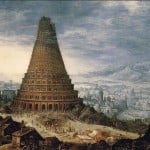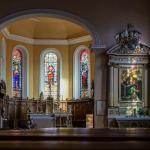This coming Easter morning, many people will rise and look east. Some will go to a Christian church for their only visit this year. Many will be reminded by priests and preachers that this one day is not enough. Those strangers to churches will be telling the oldest of religious truths: it is the people, not the priests, who make the gods.
“Easter” we call the day, namesake of a deity of the Northlands, Eostre, goddess of the dawn. English speakers still call the direction she arises from “east.” She is the goddess of new beginnings and of fertility, her day celebrated as the earth comes back to life after a long winter.
The holiday (holy day) called Easter is a movable feast, tied to both the cycles of the sun and of the moon—Easter occurs on the first Sunday after the first full moon after the equinox.
Religious holidays are celebrations of recurrence. Children in the Northlands have been searching the wet, awakening grass for eggs on Easter morning for thousands of years. The celebration has spread to other lands; to other religions. To the far corners of the planet.
Nineteenth Century German philologist Jacob Grimm reported that in some remote German villages of his time people still celebrated Eostre with sword dances, bonfires, and the baking of “heathenish pastries.”
It’s difficult this time of year—at least in the top half of the Northern Hemisphere—not to think of new beginnings. Difficult not to dance just a little bit. The iron grip of the deathly ice is finally broken and life is emerging from the long-dead earth again.
This is one of only two days the so-called “C and E” (Christmas and Easter) Christians—also known as Chreasters—fill churches. There are something on the order of eighty-five million Chreasters in the United States.
Statistics indicate that less than one-quarter of US Christians attend church even once a month. But Easter brings ‘em out—even more than Christmas or Mother’s Day(!). Why? Might it be because Easter is such a blend of religious traditions?
Reflect on the potpourri of religions and cultures that make up the concept of Easter as it is celebrated in the United States today. We have a fertility goddess from Northern Europe who survived the invasion of a Southern European tradition, Christianity, based on a Middle Eastern tradition, Judaism, itself an amalgam of religious thinking from the earliest agricultural civilizations of Mesopotamia with a pinch of Zoroastrianism from a certain Babylonian captivity thrown in.
All those ideas added up to create a lunar holiday celebrating a solar god in a myth echoing human sacrifice that originated in Egyptian mythology concerning the god Osiris, a metaphor for the planting and growth of vegetation in the Nile delta.
All that adds up to Easter brunches. And chocolate.
Why Easter? Why is Easter Christianity’s greatest hit?
“Syncretism” is one of those ten dollar words that permeates theology. The word describes the human propensity for combining religious ideas from various traditions.
The poet Wallace Stevens—an atheist by the by—made a very good point when he said, “The people, not the priests, made the gods.” Yes. The people, not the priests, meld ideas to create their religions.
Reflect on one of the greatest failures of human history. In 1231 the Roman Catholic Church opened its Office of Inquisition, nowadays known as the Congregation for the Doctrine of Faith. Yes, it’s still in existence. Yet, after nearly 800 years of terror and cajoling, there are more heresies now than ever.
Wallace Stevens continues to be correct: the people, not the priests, make the gods. And we the people continue to vote with our feet. And the more information that flows on our nets and our webs, the more people are going to . . . well, what are we people going to do?
Some will become Cheasters. Some double-belongers. Some nones.
Return to the case of the goddess Eostre. The story goes that Pope Gregory the Great was walking one day in a slave market in Rome. This was in the 600’s CE. Pope Gregory saw a couple of blonde slaves and asked his handlers where blondes came from. The handlers said they were Angles, which at the time meant either the English or Northern Germans. The pope was so taken with these blondes that he decided to devote his life to converting the Northlands to Christianity.
In 601 CE Pope Gregory instructed the missionaries he was sending to England with these words:
. . . the temples of the idols in those nations ought not to be destroyed; but let the idols that are in them be destroyed; let holy water be made and sprinkled in the said temples, let altars be erected, and relics placed.
For if those temples are well built, it is requisite that they be converted from the worship of devils to the service of the true God; that the nation, seeing that their temples are not destroyed . . . may the more familiarly resort to the places to which they are accustomed.
Syncretism. Gregory’s order was an act of genius. It was a strategy that led to a Christendom that included the far North. But it also introduced a blue note; a note of mystery. Were those people out in the country—“paganus,” pagans, which means “villagers” or “rustics” in Latin—were those pagans, were those people of the heath, those people of the wastelands, those heath-ans—were those away from the centers of power, away from the army and the police of the king and pope and bishop—were they really Christian? Or were they going to their old temples for other reasons?
No one ever knew for sure. And we never will know. But is it a coincidence that the largest concentration of atheists on the planet today . . . happen to live in those Northlands that Pope Gregory Christianized?
Syncrenism. The people, not the priests, make the gods. In computer speak, it’s called Open Source: people with different agendas; different talents; different points of view, all have access to a program. And the result is a better program than those developed through controlled access. Maybe that’s why Easter is Christianity’s greatest hit.
The people, not the priests, make the gods. Religions are the oldest open source software.











